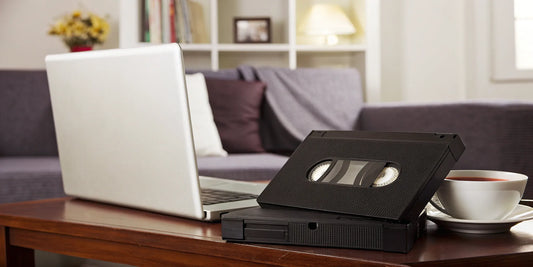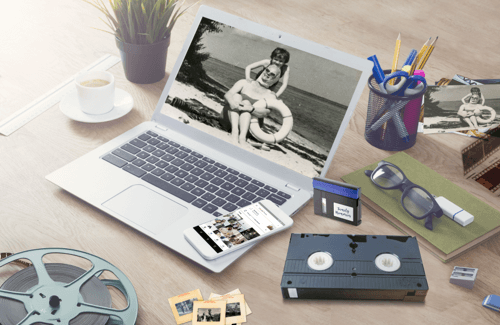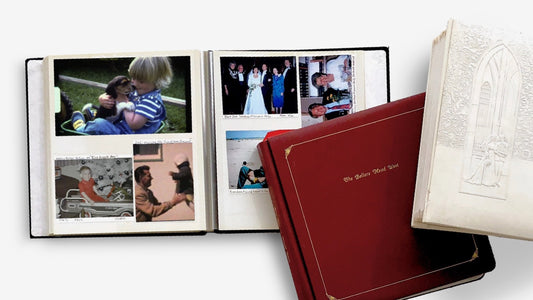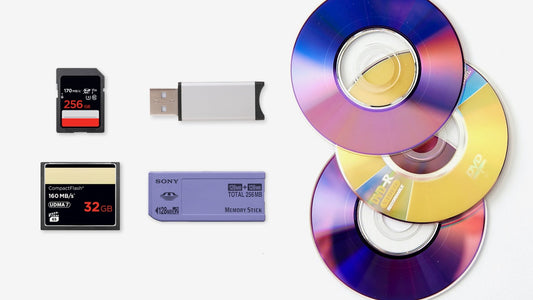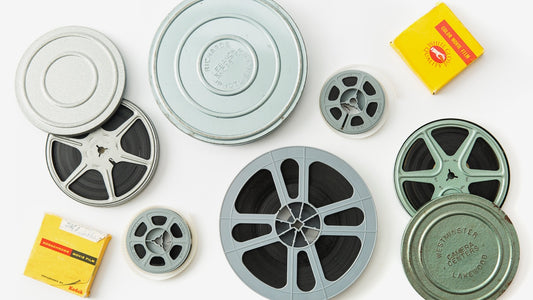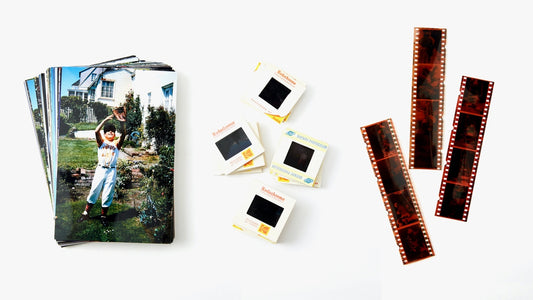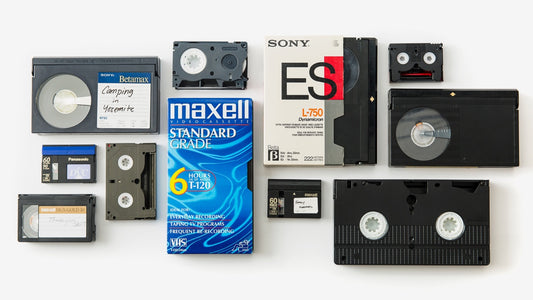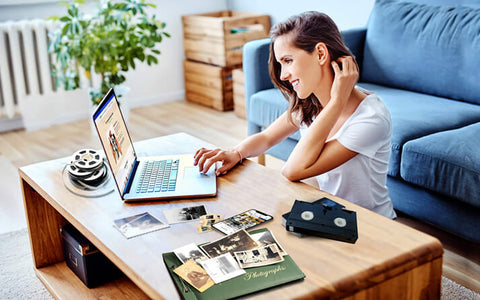Your family’s history isn’t just in photo albums; it’s on those MiniDV, Hi8, and VHS-C tapes collecting dust. These tapes are more than plastic—they’re irreplaceable moments. But they have a limited lifespan, and the clock is ticking. The best way to protect these memories is to digitize them. While it might seem technical, learning how to transfer camcorder tapes to computer is a project you can absolutely handle. This guide walks you through everything you need: the right hardware, the best software, and the exact steps to create a lasting digital archive of your most cherished videos.
Key Takeaways
- A Successful DIY Transfer Starts with the Right Gear: You'll need your original camcorder, the correct cables, and a video capture device to connect to your computer. Be prepared for the transfer to take as long as the tape's runtime, as it records in real-time.
- Preserve Your Work by Organizing and Backing Up: After transferring, edit your videos and sort them into labeled folders. The most crucial step is creating at least two backups (one physical, one cloud) to ensure your memories are safe from digital loss.
- A Professional Service is a Stress-Free Alternative: If the technical steps feel overwhelming, a professional service like YesVideo uses specialized equipment to handle fragile tapes and ensure the best possible quality, saving you time and potential frustration.
Your Camcorder Transfer Toolkit
Before you start connecting cables, let's get everything organized. A little prep work now will make the entire transfer process much smoother and save you from any frustrating surprises later on. Think of it like gathering your ingredients before you start baking. By having everything you need ready and in one place, you can focus on the fun part: bringing your precious memories into the digital age. This initial setup is straightforward, and getting it right is the first step toward a successful transfer.
What Kind of Camcorder Tape Do You Have?
First things first, you need to know exactly what kind of tape you're working with. Take a close look at your camcorder tapes; you should see a label on the cassette or its case, like MiniDV, Hi8, Video8, or VHS-C. This detail is crucial because the format determines the specific camcorder and cables you'll need. If you can't find a label on the tape, check the camcorder itself, as the format is usually printed on the body or near the tape compartment. Knowing your format is the key to the whole process, so take a moment to identify what you have. If you discover you have a variety of formats, a professional video transfer service can be a simple solution.
Your Essential Equipment Checklist
Once you know your tape format, it's time to round up your gear. You'll need the original camcorder that can play your tapes, and you’ll want to confirm it’s still in good working order. Next, you'll need a video capture device. This is typically a small adapter that connects your camcorder to your computer's USB port, acting as a bridge to convert the analog signal to a digital file. These devices usually come with the basic software you'll need for the transfer. Finally, make sure you have the correct cables to connect the camcorder to the capture device and a computer with enough free hard drive space to store your new video files.
Your Computer's Performance Matters
Transferring video is a much bigger job for your computer than just saving a photo or document. It's a resource-intensive process, and its success really depends on your computer's processing power, memory (RAM), and hard drive speed. An older or slower machine might struggle to keep up, leading to frustrating issues like dropped frames—those little stutters that interrupt your video—or the transfer might fail completely. It's also worth noting that some older camcorders use a Firewire port, which isn't common on modern computers. If that's your situation, you may need to install a special card to make the connection.
To give your transfer the best chance of success, let your computer focus entirely on the task at hand. Before you start, close all other applications, disconnect from the internet, and you might even want to pause your antivirus software temporarily. This frees up your computer's resources to handle the heavy lifting that video capture requires. The process of moving these large video files needs a powerful processor to work smoothly. If all this sounds a bit too technical or you're concerned your computer isn't quite up to the job, don't worry. Using a professional service is a great alternative, as they have high-end, dedicated equipment to ensure a perfect transfer without the headache.
Connecting Your Camcorder to a Computer
Getting your camcorder and computer to talk to each other is the most technical part of the transfer process, but it’s completely doable. Think of it as building a small bridge for your memories to cross over from your tapes to a digital format. The connection you use will depend on your camcorder’s age and the ports available on your computer. Most setups involve three key pieces of hardware: your camcorder, your computer, and a video capture device that acts as a translator between the two.
If you have a newer camcorder, you might be able to connect it directly to your computer with a single USB or Firewire cable. However, for most older analog camcorders (the kind that use VHS-C, Hi8, or MiniDV tapes), you'll need an external video capture device. This little gadget typically has analog inputs (like RCA or S-Video) on one side and a USB plug on the other. It converts the analog video signal from your camcorder into a digital format your computer can understand. If your camcorder records onto mini DVDs, the process is even simpler—you can often just pop the disc into your computer’s DVD drive to access the files.
Understanding Your Connection Options
Now that you have your gear, it’s time to make the connection. The specific cables you’ll use depend entirely on your camcorder’s age and technology. Think of it as finding the right key for the right lock. Digital camcorders, like those that use MiniDV tapes, often use a single, high-speed cable for a direct digital transfer. Older analog camcorders, which use formats like Hi8 or VHS-C, rely on different cables that send an analog signal to a capture device for conversion. Identifying which type of connection you need is the most important step in bridging the gap between your old tapes and your new digital library.
Firewire for Digital Tapes
If you're working with digital tapes like MiniDV, your best bet for a high-quality transfer is a Firewire connection, also known as i.Link or IEEE 1394. This cable creates a direct digital-to-digital link between your camcorder and computer, essentially copying the data without any loss in quality. It’s the cleanest way to move your video files. The main challenge is that most modern computers no longer have built-in Firewire ports. If that’s the case for you, don’t worry—you can easily find a Firewire-to-USB or Firewire-to-Thunderbolt adapter online or at an electronics store to complete the connection.
Analog Connections for Older Tapes
For older analog formats like VHS-C, Hi8, or Video8, you'll be using different cables. The most common are the iconic RCA cables (the yellow plug for video, and the red and white plugs for audio). Some camcorders might also have an S-Video port, which offers slightly better video quality by separating the color and brightness signals. These cables don't plug directly into your computer. Instead, they connect your camcorder to an external video capture device, which then plugs into your computer's USB port. It’s important to know that this process happens in real-time. That means if you have a two-hour tape, the transfer will take two hours to complete, so be sure to set aside enough time.
Your Step-by-Step Hardware Setup
Let's get your hardware connected. First, find the A/V (audio/video) output port on your camcorder. Connect your RCA or S-Video cable to the camcorder, then plug the other end into the matching inputs on your video capture device. Next, plug the capture device’s USB cable into an available USB port on your computer. Most capture devices come with their own software, so be sure to install it before you begin. This software is what you'll use to record the video playing from your camcorder. Once everything is plugged in and the software is installed, your computer should be able to recognize your camcorder as a video source.
Connection Problems? Try These Fixes
If your video isn't showing up on your computer, don't panic. The most common issue is simply using the wrong cable. Not all A/V cables are wired the same, especially those with a 3.5mm jack on the camcorder side. Double-check that you have the correct one for your specific model to avoid connection issues or even potential damage to your gear. If you have an older Mac or PC, you might have a Firewire port, which was a common connection for MiniDV camcorders. Also, keep in mind that transferring video is a demanding task for your computer, so a slow or choppy transfer could mean your processor is struggling to keep up.
Why the USB Port Might Not Work
You might notice a USB port on your old camcorder and think it’s your ticket to an easy transfer. Unfortunately, for most older models, this port is a dead end for video. Back when these camcorders were made, USB technology wasn't fast enough to handle video data. Instead, that port was typically designed for transferring low-resolution still photos from the tape, not the moving footage. Trying to use it for video transfer will only lead to frustration, as your computer won't recognize the video stream. It’s best to ignore the USB port entirely and focus on using the A/V or Firewire outputs, which were specifically designed for this purpose.
Using an Older Computer with a Firewire Port
If you're working with digital tapes like MiniDV or Digital8, your best bet for a high-quality transfer is a Firewire connection. While modern computers rarely include this port, many older PCs and Macs from the mid-2000s came with it built right in. If you happen to have an old desktop or laptop from that era, you might have the perfect tool for the job already. Pairing an older computer that has a Firewire port with software like Windows Movie Maker or an early version of iMovie can create a seamless, high-fidelity transfer directly from your camcorder. It’s a surprisingly effective solution that leverages the technology these cameras were designed to work with.
Adding a Firewire Port to a Modern PC
What if you don't have an old computer lying around? If you have a modern desktop PC, you can still get a Firewire connection by installing a dedicated Firewire card. These are inexpensive expansion cards that plug into a PCIe slot on your computer's motherboard, giving you the ports you need for a direct digital transfer. This option is great for anyone who is comfortable opening up their computer case and wants to achieve the best possible quality from their MiniDV or Digital8 tapes. It’s a small hardware upgrade that can make a huge difference in preserving the original clarity of your digital home movies.
Checking Your A/V Cables
For analog tapes, the A/V cable is your lifeline, but it's also a common source of trouble. It’s important to know that not all A/V cables are created equal, especially those that use a single 3.5mm plug on the camcorder end. Different manufacturers like Sony, Canon, and Panasonic often wired these cables differently. Using a cable from the wrong brand might fit perfectly but result in a black screen or distorted audio because the internal connections don't match. Always try to use the original cable that came with your camcorder. If you can't find it, make sure you buy a replacement that is specifically listed as compatible with your camcorder model. If tracking down the right gear feels like a hassle, a professional video transfer service can take the guesswork out of the equation for you.
Choosing the Right Video Capture Software
Once your hardware is connected, you need a program to act as the bridge between your camcorder and your computer. This is where video capture software comes in. This software tells your computer to recognize the video signal from your camcorder and record it as a digital file. Think of it as the director of this operation, ensuring every frame of your precious home movie makes it safely onto your hard drive.
There are many options out there, from free, open-source programs to more advanced paid software with extra features. The right choice for you depends on your technical comfort level and what you plan to do with the videos after you transfer them. Don't worry, you don't need a Hollywood-grade program to get the job done. Many simple, effective tools are perfect for digitizing family memories. The main goal is to find a reliable program that can capture live video from your device and save it in a common format. We’ll walk through some popular choices and the key features to look for so you can pick the best tool for your project.
Our Favorite Video Capture Software
You'll find a wide range of video capture software available, and many of them work great for this kind of project. One of the most frequently recommended free options is OBS Studio. It's a powerful and versatile tool that's popular with video creators, but it's also fantastic for straightforward video capture. While it might look a little intimidating at first, its basic capture functions are fairly easy to set up. For those who prefer a paid option with more built-in features and support, programs like Camtasia or Movavi are excellent choices. They often combine capturing and editing into one package, which can be convenient.
What Makes a Great Capture Software?
When you're comparing software, the most important feature is a simple, user-friendly interface. You're preserving memories, not trying to become a professional video editor overnight. Look for software with a clear "Record" button and straightforward settings. The program should easily recognize your connected camcorder as a video source. It's also helpful if the software allows you to choose the file format and quality settings for your recording. This gives you control over the final file size. While you don't need a full suite of editing tools, having some basic editing options like trimming the start and end of your clips can be a huge plus.
How to Transfer Camcorder Tapes to Your Computer
With your hardware connected and software ready, you’re at the most exciting part: moving those precious videos onto your computer. This process happens in real-time, meaning a 60-minute tape will take 60 minutes to transfer. It’s a great time to grab a cup of coffee and keep a close eye on the process. Following these steps will help you create a clean digital copy of your home movies.
Prepping Your Gear for the Transfer
First, let's get your camcorder ready for the transfer. Pop in the videotape you want to digitize and make sure it’s rewound to the beginning. You’ll need to switch the camcorder from its recording mode to the playback setting, which is usually labeled ‘VCR’ or ‘VTR’ (Video Tape Recorder). This allows the computer to read the footage from the tape.
Next, take a look at your computer. If you have an older computer, you might find a Firewire port, which makes for a simple connection. If not, don't worry—this is where your video capture device comes in. This little piece of hardware acts as a bridge between your analog camcorder and your modern computer, ensuring they can communicate properly.
Minimize Distractions for a Smooth Transfer
Transferring video is a marathon, not a sprint, for your computer. Because the process happens in real-time, your machine needs to focus entirely on capturing the video feed without any interruptions. To ensure a clean transfer, close all other applications—no checking email or browsing the web. It’s also wise to disconnect from the internet and temporarily pause your antivirus program, as background scans can cause glitches. If your transfer seems choppy or slow, it’s a sign your computer is struggling to keep up with the demanding task. Giving it one job to do prevents dropped frames and makes the difference between a perfect digital copy and a frustrating, flawed one.
The Video Capture Process: Step by Step
Once your devices are connected, it’s time to start the transfer. Open the video capture software you installed on your computer. You should see a window that will display the video from your camcorder. Get ready to perform a little bit of synchronized clicking. You’ll need to press the ‘record’ button in your software and the ‘play’ button on your camcorder at roughly the same time. Your video will begin playing on your camcorder and recording onto your computer. If the process feels a bit complicated, remember that a professional video transfer service can handle all of these technical steps for you.
Tips for Managing Large Files and Transfer Times
A quick heads-up: this part of the process requires some patience. Because you are converting an analog signal to a digital file in real-time, the resulting video files can be quite large. It’s a good idea to check that you have plenty of free space on your computer’s hard drive before you begin.
The transfer will take exactly as long as the tape’s runtime. If you have a two-hour tape, set aside two hours for the transfer. During this time, it’s best to avoid using your computer for other intensive tasks, as this can sometimes cause the recording to skip or drop frames. This is one of the biggest benefits of using a service like YesVideo for film transfer, as our technicians ensure a smooth, high-quality capture from start to finish.
Editing and Organizing Your Digital Videos
Getting your videos onto your computer is a huge win, but the real magic happens next. This is where you get to polish your raw footage into treasured family movies you’ll watch again and again. With your videos digitized, you have the power to trim away the shaky bits, add a little flair, and organize everything so it’s safe and easy to find for years to come. Think of it as creating your family’s own digital time capsule. You're not just preserving footage; you're curating stories. This is your chance to cut out the five minutes of filming the ground and get straight to the moment the birthday candles were blown out. By editing and organizing, you transform hours of recordings into highlights that everyone will actually love to watch. It’s the final, crucial step in making sure these memories are not just saved, but truly cherished and ready for the next family movie night. This process ensures your efforts pay off, resulting in a clean, accessible library of your most precious moments. Instead of a folder of cryptically named files, you'll have a collection that's easy to browse, share, and enjoy without any guesswork.
Quick and Easy Editing Techniques
You don’t need to be a Hollywood director to make your home movies shine. Most computers come with free, user-friendly video editing software (like Photos on Windows or iMovie on a Mac) that’s perfect for the job. You can start with simple changes that make a big impact. Try trimming the beginning and end of clips to get right to the action. You can also add text titles to note the date and event, like “Christmas 1995” or “Sarah’s 5th Birthday.” Adding a favorite song as background music can also completely change the feel of a video, turning a simple recording into a heartfelt montage. Play around with the tools; you’ll be surprised at how easy it is to create something special.
How to Create a Digital Video Archive
Now that you’ve put in the work to transfer and edit your videos, the most important step is to protect them. A single copy on your computer isn’t enough—hard drives can fail. Create a backup by saving your video files to an external hard drive and also to a cloud storage service like Google Drive or Dropbox. This ensures your memories are safe from accidents. Once backed up, you can organize your files into folders by year or event. This makes it easy to find exactly what you’re looking for. You can even use your computer as a media hub to play your videos on a smart TV, making your next family movie night a trip down memory lane. If you have other digital files scattered around, a digital media transfer can help you consolidate everything into one beautifully organized collection.
Preserving Your Digital Videos for the Long Haul
You’ve successfully transferred your camcorder tapes to your computer—congratulations! That’s a huge step. Now, let's make sure all that hard work pays off by protecting these digital files and the original tapes for the long haul. Proper storage and care are what will keep these moments alive for your kids, grandkids, and even great-grandkids to enjoy. It’s all about creating a lasting family archive that stands the test of time.
Which File Format Is Best for Long-Term Storage?
When you save your newly digitized videos, the file format you choose matters more than you might think. Think of it like choosing between a VHS tape and a DVD back in the day—one is much easier to use now. For your videos, you'll want to save them in widely used formats like MP4 or MOV. These are the gold standard because they work on almost any device, ensuring your memories stay accessible for years to come. Once you have your files, making backups is essential. You can save copies on an external hard drive, a cloud service, or even turn your PC into a media server to stream videos throughout your home.
How to Properly Store Your Original Tapes
Even after you’ve digitized them, you might want to keep your original tapes for sentimental reasons. To keep them from deteriorating, store them in a cool, dry place away from direct sunlight. Basements and attics are often too humid or experience extreme temperature swings, which can damage the delicate magnetic tape. Remember that these tapes degrade over time, which is why it's so important to digitize them sooner rather than later. If you're worried about handling fragile old media, a professional video transfer service can be a great option to ensure your memories are preserved safely and correctly from the start.
Troubleshooting Common Transfer Problems
So, you’ve gathered your tapes and cables, but the transfer isn’t going as smoothly as you’d hoped. Don’t worry—hitting a snag is a normal part of the DIY process, and you’re definitely not the first person to run into a stubborn connection or a glitchy playback. Whether your computer isn’t recognizing your camcorder or the video quality looks off, most issues have a straightforward fix. It often comes down to having the right connections and giving your computer the space and power it needs to handle the job.
Think of it like this: you’re asking modern technology to communicate with hardware that might be decades old. The tapes themselves may have degraded slightly over time, and the ports on your camcorder haven't been used in years. This process can feel a bit like detective work, but with a little patience, you can usually pinpoint the problem. We're here to help you through it. Let’s walk through some of the most common hurdles and how you can clear them to get your precious memories safely onto your computer, looking as good as you remember them.
Common Problems and How to Fix Them
One of the first roadblocks many people face is simply getting the computer to see the camcorder. If your computer doesn't have a Firewire port, you'll likely need an external video capture device to bridge the gap between your camcorder’s analog outputs and your computer’s USB port. Another point to remember is that video capture is very demanding on your computer’s processor. If the transfer is slow or freezing, try closing all other applications. This gives your computer the focus it needs to capture the video without interruption. The specific tape format you're using, like MiniDV or VHS-C, also determines the exact cables and adapters you need, so double-check that you have the right gear.
How to Get the Best Video Quality From Your Tapes
Once you’re connected, the goal is to get the best possible digital copy. The quality of your transfer often depends on the analog-to-digital conversion. This process creates very large files, and if your computer struggles, it can result in dropped frames and choppy playback. To avoid this, make sure you have plenty of free space on your hard drive before you begin. A high-quality adapter can also make a significant difference in the final result. If you’re finding the process too technical or you’re not satisfied with the quality, it might be time to consider a professional service. A dedicated video transfer service handles all the technical work for you, ensuring your memories are preserved with the best possible quality.
DIY vs. Professional Transfer Services
If the steps for transferring your tapes feel a bit overwhelming, you’re not alone. The process requires specific equipment, software, and a good deal of patience. The good news is you have other options. Whether you want to try a different do-it-yourself approach or hand the project over to an expert, you can still successfully digitize those precious home movies.
Sometimes, the most direct path isn’t the right one for you. Your camcorder might have a simpler connection method, or you might find that your computer isn’t quite up to the task. Let’s look at a couple of alternative routes you can take. One path involves slightly different hardware for a DIY transfer, while the other lets you pass the work to a trusted service so you can sit back and wait for your digital memories to arrive.
Other DIY Transfer Methods to Consider
Before you commit to buying a specific capture device, check your camcorder for a USB port. Some later models allow you to connect directly to your computer for a much more straightforward transfer. If you’re working with older analog tapes, you’ll still need an adapter to get your camcorder’s AV output to talk to your computer’s input. Keep in mind that AV cables aren’t always standardized, so finding the right fit can sometimes be a process of trial and error. Many people find success using a dedicated video capture card, which is a device designed specifically for this process and often comes with its own user-friendly software.
Using a VCR for Playback
If your original camcorder is no longer working or the playback is fuzzy, you might have another option sitting in your entertainment center: a VCR. For analog tapes like Hi8 or VHS-C (which fits into a special adapter), a VCR can sometimes provide a more stable and cleaner playback than an old, worn-out camcorder. The connection process is nearly identical; you’ll run the A/V cables from the VCR’s output ports to your video capture device. This can be a great workaround if your camcorder’s playback heads have seen better days. If you don't have a working VCR or the tapes are too fragile to risk playing, a professional video transfer service is your safest bet for preserving those memories.
Transferring from HDD or Memory Card Camcorders
If your camcorder is a bit more modern and records onto a built-in hard drive (HDD), a memory card, or even a MiniDVD, your job just got a lot easier. Since the video is already in a digital format, you can often skip the real-time capture process. Simply connect the camcorder to your computer using a USB cable. Your computer should recognize it as an external storage device, allowing you to drag and drop the video files directly to your hard drive. If that doesn't work, you can use a separate memory card reader. For MiniDVDs, you can either use a USB connection or, if your PC has a compatible drive, insert the disc directly. This is a great way to consolidate files, and if you have media on various old devices, a digital media transfer service can help bring it all together.
When Should You Hire a Professional?
While a DIY transfer is rewarding, it can be demanding on your computer and your time. The process requires a good amount of processing power, and if your tech setup isn't quite right, it can lead to frustration. If you don’t have the equipment, feel short on technical know-how, or simply want to ensure the highest quality result without the headache, it’s a great time to call in the professionals. A dedicated video transfer service has the specialized equipment and expertise to handle your tapes with care. They can manage different formats and potential tape degradation, ensuring your memories are preserved safely and effectively for you to enjoy.
Handling a Wide Range of Formats
One of the biggest challenges in a DIY project is discovering you have a mix of different tape formats. A box of family memories can easily contain MiniDV, Hi8, and even VHS-C tapes from various camcorders used over the years. Each format requires a specific player and sometimes different cables, which can quickly turn your simple project into a complicated and expensive hunt for old equipment. How you transfer your videos depends entirely on the gear you have. If you’re facing a collection of assorted tapes, a professional service is often the simplest solution. At YesVideo, we have the professional-grade equipment to handle a wide variety of formats, ensuring all your memories, no matter the tape type, are digitized with care.
The Benefits of a Professional Service
If the technical steps of connecting hardware and troubleshooting software feel overwhelming, you can always hand the project over to experts. A professional service saves you time and potential frustration by using specialized equipment designed to get the best possible quality from your old tapes. This is especially important if your tapes are fragile or showing signs of age. Professionals know how to handle delicate media to prevent damage during the transfer process. Choosing a trusted service like YesVideo means you can skip the technical setup and be confident that your irreplaceable memories are being processed by hand, by experts who do this every day.
Understanding the Costs and Turnaround Time
When considering a professional service, it’s helpful to know what to expect. Most services charge on a per-tape basis, and many offer discounts for larger orders, which is great if you have a big collection to digitize. While prices vary, you can often get a single tape converted for a reasonable fee. The entire process, from sending your tapes in to receiving your digital files, typically takes a few weeks. It’s a small investment of time for a lifetime of access to your family’s history. For a clear idea of what your project might cost, you can check out our video transfer page for current pricing and options.
Copyright and Legal Considerations
Here’s a quick but important note: you should only digitize content that you personally own. This means your home movies are perfect for this project, but you can’t legally convert commercially produced tapes, like a store-bought movie or a TV show you recorded. Professional transfer services operate under this same rule and will only process personal recordings to which you own the rights. This policy ensures that everyone is respecting copyright law. It’s all about preserving your personal legacy and the unique moments that belong to your family, ensuring those are the memories that get passed down through generations.
Related Articles
- VHS Tape to Digital: The Ultimate 2024 Guide – YesVideo
- Best VHS Video to Digital Converters: Top Picks – YesVideo
- Convert Hi8 to Digital: Your 3 Best Options – YesVideo
- Video Tape to Digital: DIY or Pro? Your Best Bet – YesVideo
- 3 Ways to Convert VCR Tapes to Digital – YesVideo
Frequently Asked Questions
What if my original camcorder is broken or I can't find it? This is a really common situation, so don't worry. If your camcorder is no longer working, you won't be able to play the tapes for a DIY transfer. Your best option is to use a professional service. Companies like YesVideo have a whole library of well-maintained equipment specifically to play and digitize nearly every tape format ever made, ensuring your memories can be saved even if your original gear is long gone.
How much computer space will my videos actually take up? Video files are notoriously large, and it’s smart to plan ahead. As a general rule, you can expect one hour of standard-definition video to take up about 13 gigabytes of space. Before you start a transfer, it's a good idea to check your computer's available storage and clear some room or plan to save the files directly to an external hard drive.
Why can't I just record my camcorder's playback screen with my smartphone? While that might seem like a quick fix, you'll lose a significant amount of quality. Filming a screen introduces glare, distortion, and poor audio, resulting in a blurry and washed-out copy of your original footage. A direct transfer using a capture device preserves the video's original quality, giving you a much clearer and more faithful digital version of your memories.
My video looks choppy or grainy after the transfer. Can I fix it? Unfortunately, post-transfer quality issues are often difficult to fix with basic editing software. Choppiness can happen if your computer's processor was overloaded during the real-time capture, while graininess might be a sign of the original tape's age. A high-quality capture device can help, but this is where professional services really shine, as they use specialized hardware designed to create the smoothest, highest-quality transfer possible from aging tapes.
I have a mix of different tape types. Do I need different equipment for each one? Yes, you most likely will. Formats like VHS-C, Hi8, and MiniDV each require their own specific camcorder or player for playback. If your family collected tapes across different eras, a DIY project would mean tracking down working equipment for every single format. This is another scenario where a professional service simplifies things by handling all the different formats for you in one go.




